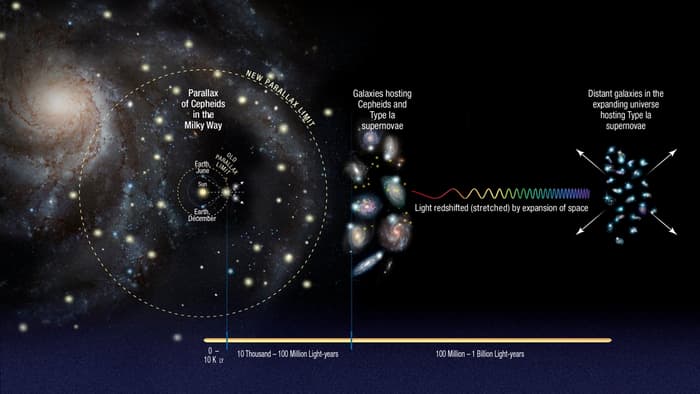New measurements carried out using the Hubble Space Telescope suggest that the Universe may be expanding up to 9 percent faster than previously believed. The team behind the study, which is the most accurate of its kind ever undertaken, believe that the culprit for the unexpected acceleration could be one of the invisible phenomena thought to comprise roughly 95 percent of the Universe.
The new study observed the light signatures of around 2,400 Cepheid variable stars in 19 different galaxies, as well as those of 300 Type Ia supernova. Cepheids and Type Ia supernovae constitute part of the Cosmic Distance Ladder – an invaluable tool for astronomers attempting to map the vast distances between galaxies.
Celestial objects that fall into this category boast a known quantity that can be measured with a high degree of accuracy. For example, we know how bright a Type Ia supernovae will shine, and have identified a strong relationship between a Cepheid star's brightness and its pulsation period.
The team compared the observations of the study subjects with the stretching of light from receding galaxies, which astronomers use to mark the stretching of space, allowing the researchers to calculate the speed of universal expansion. This value is known as the Hubble constant.
Following the most recent set of observations, the astronomers charged with mapping the expansion of the Universe, known as the Supernova H0 for the Equation of State (SH0ES) team, have reduced the level of uncertainty in the Hubble Constant to a mere 2.4 percent. The latest figure represents a 76 percent reduction in uncertainty regarding the Hubble constant since SH0ES began its work in 2005.
The current rate of expansion is set at 45.5 miles per second per megaparsec, between 5 – 9 percent faster than expected in models predicated on observations made of the afterglow of the big bang. The SH0ES team predict that in another 9.8 billion years, the distances between cosmic objects will double.
"You start at two ends, and you expect to meet in the middle if all of your drawings are right and your measurements are right," states Nobel Laureate Adam Reiss of the Space Telescope Science Institute and John Hopkins University, Baltimore. "But now the ends are not quite meeting in the middle and we want to know why."
The team suspect that the culprit for the unaccounted factor responsible for the acceleration could lurk amongst the 95 percent of the Universe that emits zero light, namely dark matter, dark energy, or dark radiation. The phenomena themselves cannot be observed directly. Instead, astronomers study them through the influence they exert on vast constructs of visible matter such as galaxies and superclusters.
It is possible that dark matter is responsible for the acceleration thanks to a characteristic that we are simply yet to discover due to our limited observational capabilities. The discrepancy could also suggest that Einstein's theory of gravity is incomplete when working with objects on a universal scale.
Alternatively, dark energy, a force already heavily suspected of increasing the Universe's expansion, could be more potent than previously thought. Finally, a family of subatomic particles that travelled close to the speed of light known as dark radiation could have provided the extra energy to accelerate the early Universe.
Moving forward, the team intends to use the next generation of ground and spacefaring telescopes such as the James Webb Space Telescope (JWST) and the ESO's European Extremely Large Telescope (E-ELT) to reduce the uncertainty in the Hubble constant to 1 percent.
Source: Hubble Space Telescope

